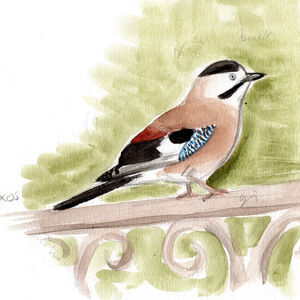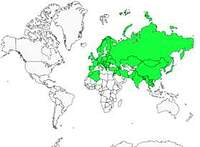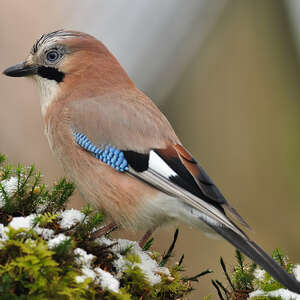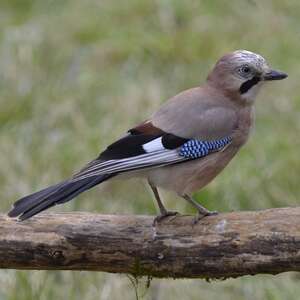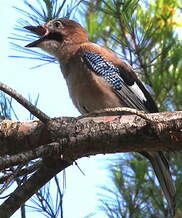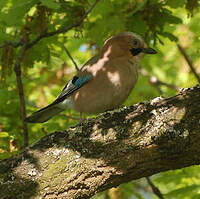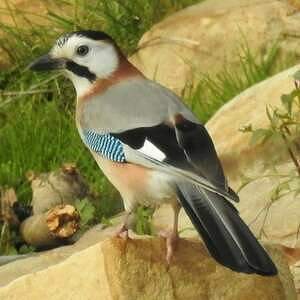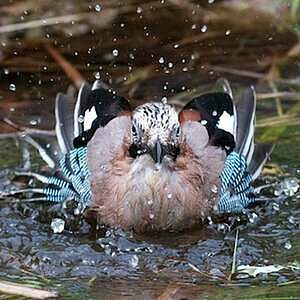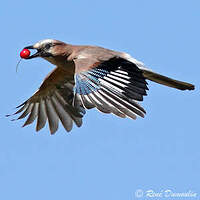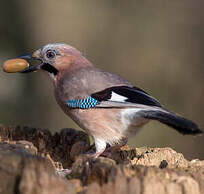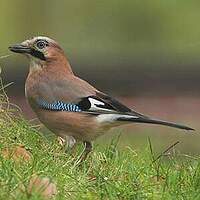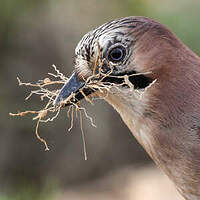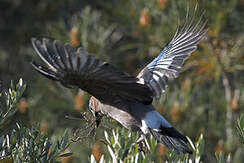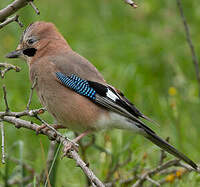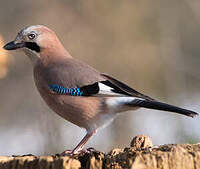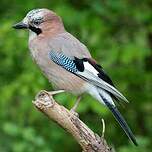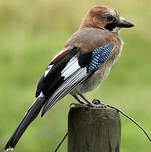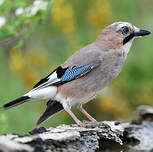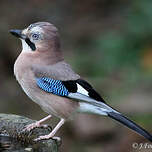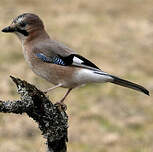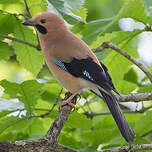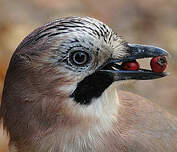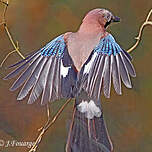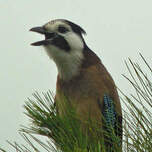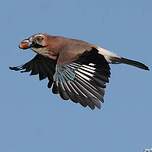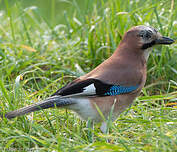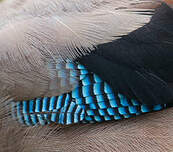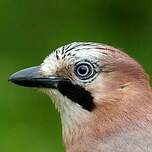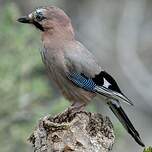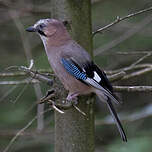Eurasian Jay
Garrulus glandarius - Geai des chênes
Identification
Unlike most members of the Corvidae family, the Eurasian Jay has brightly coloured feathers that draw attention. Because of this, it is easily recognizable. There is no sexual dimorphism and all the feathers look similar. Here, we describe the North European subspecies 'glandarius', which inhabits France.
Most of the body is a clear brown-beige with bits of pinkish or reddish tones. The head is the most brightly coloured with reddish cheeks. This contrast with the mantle and scapular feathers, the palest parts of the body. The face is whitish, with black moustache under the eyes and with fine black stripes on the front feathers and atop the head which the bird ruffles when excited. The iris is blue-white. The beak is fairly short and black.
The wing is mostly black, although that can best be seen when in flight. When the wing is closed, one can mostly perceive a vivid blue patch at the front. The primary coverts and greater outer coverts are sky-blue and barred in dark blue. Behind this patch, a clear white panel on a black background can be distinguished, formed by the pure whit bases of the five outermost secondary remiges. Finally, just behind, a vivid brown can be distinguished on the two innermost tertiary remiges, which is also likely to shade the second pair. The combination of all these colours creates the typical colourful pattern of the species. The primary remiges are lined in white, which creates a pale band visible along the external side of the wing.
The uppertail coverts and undertail coverts and the rump are white and, when the bird is in flight, one cannot miss the clear white patch at the base of the black tail, which is also a distinctive feature of the species. The legs are fleshy-brown.
With 34 described subspecies, the species is highly polymorphic, yet always recognizable as such.
Subspecific information 34 subspecies
- Garrulus glandarius glandarius (n and c Europe to the Ural Mts.)
- Garrulus glandarius hibernicus (Ireland)
- Garrulus glandarius rufitergum (Scotland, England, Wales and nw France)
- Garrulus glandarius fasciatus (Iberian Pen.)
- Garrulus glandarius corsicanus (Corsica)
- Garrulus glandarius ichnusae (Sardinia)
- Garrulus glandarius albipectus (Italy, Sicily and the Dalmatian coast)
- Garrulus glandarius graecus (w Balkans including Greece)
- Garrulus glandarius ferdinandi (e Bulgaria and n Turkey)
- Garrulus glandarius cretorum (Crete)
- Garrulus glandarius glaszneri (Cyprus)
- Garrulus glandarius whitakeri (n Morocco and nw Algeria)
- Garrulus glandarius minor (c Morocco and the Atlas Mts. of n Algeria)
- Garrulus glandarius cervicalis (n and ne Algeria and Tunisia)
- Garrulus glandarius samios (Samos. se Aegean Sea.)
- Garrulus glandarius anatoliae (w Turkey to w Iran and n Iraq)
- Garrulus glandarius iphigenia (Crimean Pen.. n coast of the Black Sea.)
- Garrulus glandarius krynicki (ne Turkey and the Caucasus)
- Garrulus glandarius atricapillus (w Syria, w Jordan and Israel)
- Garrulus glandarius hyrcanus (se Azerbaijan and n Iran)
- Garrulus glandarius brandtii (s Siberia, n Mongolia, nw and ne China, Korea and n Japan)
- Garrulus glandarius kansuensis (c China)
- Garrulus glandarius pekingensis (e China)
- Garrulus glandarius japonicus (Honshu, Oshima and Kyushu. c, s Japan.)
- Garrulus glandarius tokugawae (Sado I.. off Honshu in c Japan.)
- Garrulus glandarius orii (Yakushima. s Japan.)
- Garrulus glandarius sinensis (n Myanmar, s and e China)
- Garrulus glandarius taivanus (Taiwan)
- Garrulus glandarius bispecularis (w Himalayas to w Nepal)
- Garrulus glandarius interstinctus (e Himalayas)
- Garrulus glandarius persaturatus (ne India. s Assam.)
- Garrulus glandarius oatesi (nw Myanmar)
- Garrulus glandarius haringtoni (w Myanmar)
- Garrulus glandarius leucotis (c Myanmar to c and s Indochina)
Foreign names
- Geai des chênes,
- Arrendajo euroasiático,
- gaio-comum,
- Eichelhäher,
- szajkó,
- Gaai,
- Ghiandaia,
- nötskrika,
- Nøtteskrike,
- sojka obyčajná,
- sojka obecná,
- Skovskade,
- närhi,
- gaig eurasiàtic,
- Skrækskaði,
- sójka (zwyczajna),
- sīlis,
- šoja,
- Сойка,
- カケス,
- 松鸦,
- นกปีกลายสก๊อต,
- 松鴉,
Voice song and call
As with all corvids, we cannot speak of song for the Eurasian Jay, but its vocal repertoire is very rich and it is not stingy with its calls most of the time.
The most frequent call is a loud, hoarse and raspy krreehh, with variants, as well as a repetitive heinh or reinh which is unpleasant to the human ear, but very typical. But the repertoire is vast. The Jay is particularly vocal at the end of winter at the time of pairing. Adults flock together and noisily roam the forests. If we were to speak of singing, it would be for the vocalizations emitted on this occasion, more melodious and sustained.
The Jay is capable of perfect imitations, the best known being that of the Common Buzzard.
Habitat
The Eurasian Jay is a forest bird in the breeding season. Over its wide range, it inhabits all types of forests.
Outside the breeding season, its habitat extends to semi-open areas, hedgerows, gardens and orchards, agricultural areas provided there are lines of hedges, and even urban areas thanks to parks. In winter, the Mediterranean biome, rich in evergreen woody species, welcomes many migrants from the north and east.
Behaviour character trait
The Eurasian Jay is a common bird that is heard more easily than seen. Its shrill, loud cries are unpleasant to the human ear and it is not stingy with them. It is quite shy towards humans and prefers to keep its distance. When it approaches a feeding station in winter, it does so with great caution and only if there is peace and quiet. When entering its forest territory, it is greeted by cries that alert the entire bird community. It also alarms in the same way when a predator like the Pine Marten shows up. On the other hand, it is best to stay quiet if an Accipiter comes flying and if it wishes to stay alive.
Perhaps this is the occasion when it imitates the sound of the Variable Buzzard.The Eurasian Jay is monogamous and nests by territorial couples who share the forest space. The season begins in March with loud, gestured and vocal collective displays, mentioned above. These preside over the formation of couples and apparently concern mainly the young adults in the area. This is probably the moment of the year when the species is most easily visible and audible. The couples then isolate themselves for reproduction and become very discreet. The forest returns to its calm.
The Eurasian Jay is an omnivore. It has a bad reputation due to the inclination attributed to it for the eggs and chicks of small passerines taken from the nest. Even if this predation is proven, it is probably exaggerated, but in doing so, it plays the role that nature has assigned to it. Be it as it may, when it moves through the undergrowth in spring, it is accompanied by the alarmed cries of passerines, particularly thrushes and blackbirds, who know of its danger to their offspring.
Flight
The Eurasian Jay has short and wide wings, adapted for flights in forested areas. This morphologie is not meant for long distance movements, yet the Eurasian Jay is a migratory species over a large part of its range. Its migrations between different forested areas consist of slow direct flights, and the birds look for the safety of the forest cover as soon as possible. They avoid flying in open areas.
Dietfeeding habits
As with all corvids, the Eurasian Jay is an omnivore. Seeds are its main source of sustenance in the winter.
That is why it is called the Eurasian Jay, as it is particularly fond of acorns, which constitute up to 50% of its diet in the summer, which he then stashes away for the winter. But many other seeds are also consumed, such as beechnuts or conifer seeds at higher elevations, cereal grains after the harvest, etc. Fruits are also consumed at the end of the season. It can come to winter feeding posts, attracted by the grain or fat on offer.In the spring, the animal part of the diet dominates when the resource is abundant and available. The young almost exclusively eat animals. The range of prey is very long. There are mainly invertebrates of all kinds (insects and their larvae such as caterpillars, beetles, etc.), but also small terrestrial vertebrates such as small lizards and amphibians. Aboves it was mentioned that it occasionally has a penchant for the eggs and chicks of small passerines, but this predation should not be exaggerated.
Reproduction nesting
Eurasian Jays nest in territorial couples. Nesting is arboreal. The nest is built in the forest, relatively high in a tree or shrub, usually more than 3 meters, typically against the trunk at the beginning of a branch.
It consists of a flat bed of twigs and branches 35 to 40 cm in diameter, with a fairly deep cup finely lined with rootlets in the center. It is usually well hidden from view by the foliage of the supporting tree and/or by the ivy climbing on it.The laying is abundant, 5 to 7 eggs on average, sometimes more. The eggs are typically corvid, pale green with dark green to gray-green spots. They are incubated for 16-17 days by the female. The chicks stay in the nest for 3 weeks, fed by both parents. They will become independent at 7 or 8 weeks. Eurasian Jays raise only one brood per year.
Geographic range
The Eurasian Jay's breeding range extends from the Atlantic to the Pacific across the entire Eurasian continent at temperate and sub-boreal latitudes. To the west, the Iberian Peninsula and the British Isles, and to the east the Japanese archipelago and the island of Sakhalin bound this vast continental area. In Africa, only the Maghreb is occupied. The southern limit reaches the north of Israel and the Iranian Zagros mountains. Further east, it passes well north of the desert areas of Central Asia, Mongolia, and China which are inhospitable for it. At the far east, the range extends down to central China (Qinghai and Gansu).
Threats - protection
IUCN conservation status
concern
in the Wild
threatened
evaluated
The Eurasian Jay is a common, unthreatened species, simply subject to inter-annual fluctuations. In France, it is doing well. It has recently adapted to the urban environment and is now regular in Paris parks, which reflects its adaptability.
Sources of information
- IOC World Bird List (v15.1), Gill, F and D Donsker (Eds). 2025-12-07.
- Les passereaux d'Europe, tome 1, P. Géroudet, M. Cuisin
- HBW Alive,
- xeno-canto, Sharing bird sounds from around the world,
Other sources of interest
 Specification sheet created on
05/07/2023 by Jean François
Specification sheet created on
05/07/2023 by Jean FrançoisTranslation by AI Oiseaux.net
© 1996-2026 Oiseaux.net
- Accipitriformes
- Aegotheliformes
- Anseriformes
- Apodiformes
- Apterygiformes
- Bucerotiformes
- Caprimulgiformes
- Cariamiformes
- Casuariiformes
- Charadriiformes
- Ciconiiformes
- Coliiformes
- Columbiformes
- Coraciiformes
- Cuculiformes
- Eurypygiformes
- Falconiformes
- Galliformes
- Gaviiformes
- Gruiformes
- Leptosomiformes
- Mesitornithiformes
- Musophagiformes
- Nyctibiiformes
- Opisthocomiformes
- Otidiformes
- Passeriformes
- Pelecaniformes
- Phaethontiformes
- Phoenicopteriformes
- Piciformes
- Podargiformes
- Podicipediformes
- Procellariiformes
- Psittaciformes
- Pterocliformes
- Rheiformes
- Sphenisciformes
- Steatornithiformes
- Strigiformes
- Struthioniformes
- Suliformes
- Tinamiformes
- Trogoniformes

